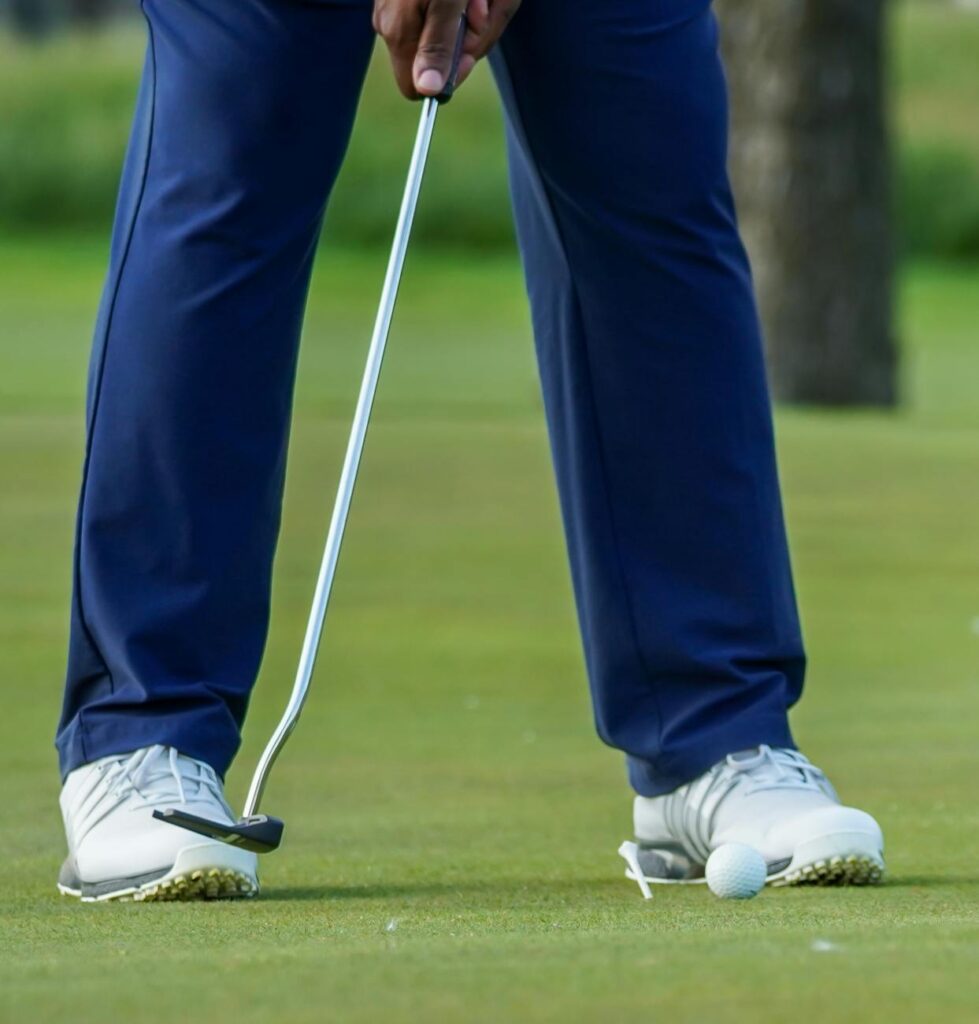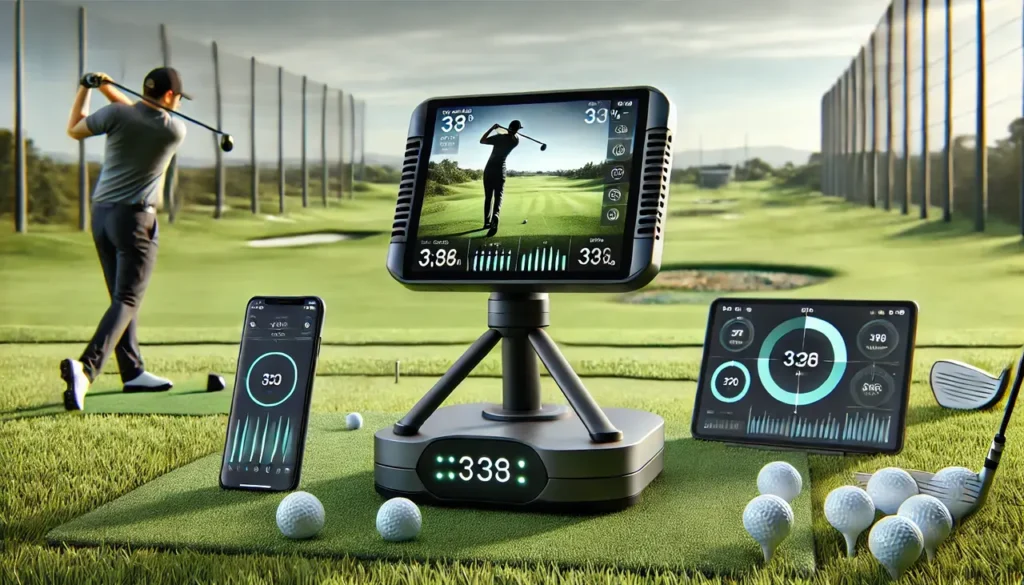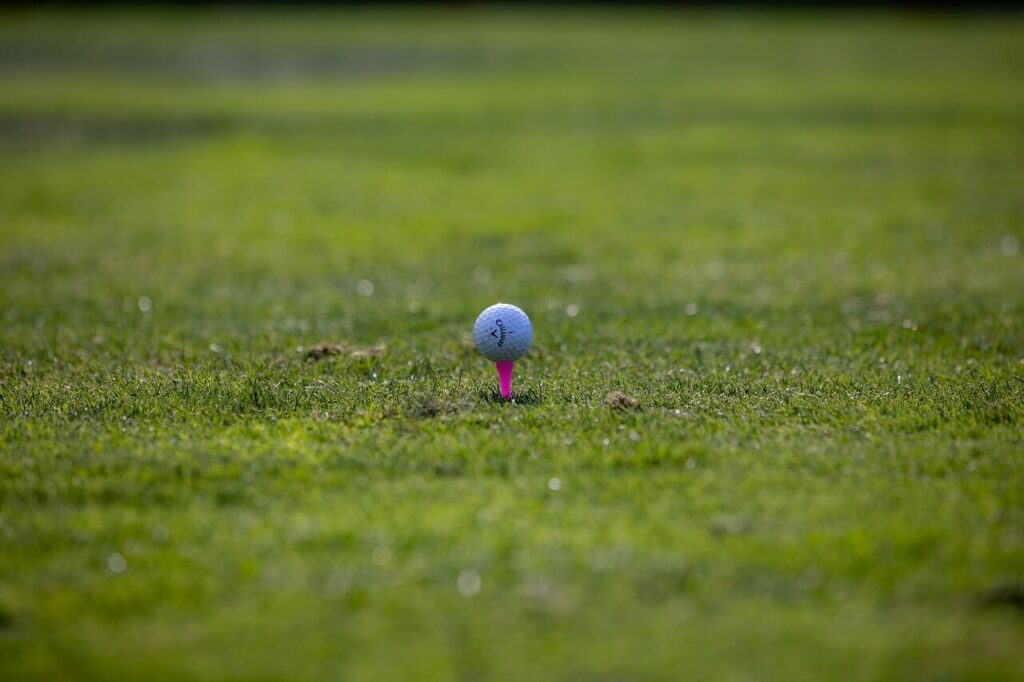Finding the best golf shoes for walking is like discovering the perfect caddie—they need to support you, keep you comfortable for miles, and give you the confidence to play your best. The right pair feels like your favorite sneakers but grips the turf like a high-performance machine, blending plush cushioning and rock-solid stability so you can focus on your game, not your feet.
- Why Your Golf Shoes Are the Most Important Club in Your Bag
- The Anatomy of the Perfect Walking Golf Shoe
- Spiked vs. Spikeless Golf Shoes: Choosing Your Sole
- How Golf Shoe Materials Impact Your Walk
- Golf Shoes: Finding the Perfect Fit to Avoid Pain
- Making Your Golf Shoes Last Longer
- Your Questions on Walking Golf Shoes Answered
Why Your Golf Shoes Are the Most Important Club in Your Bag
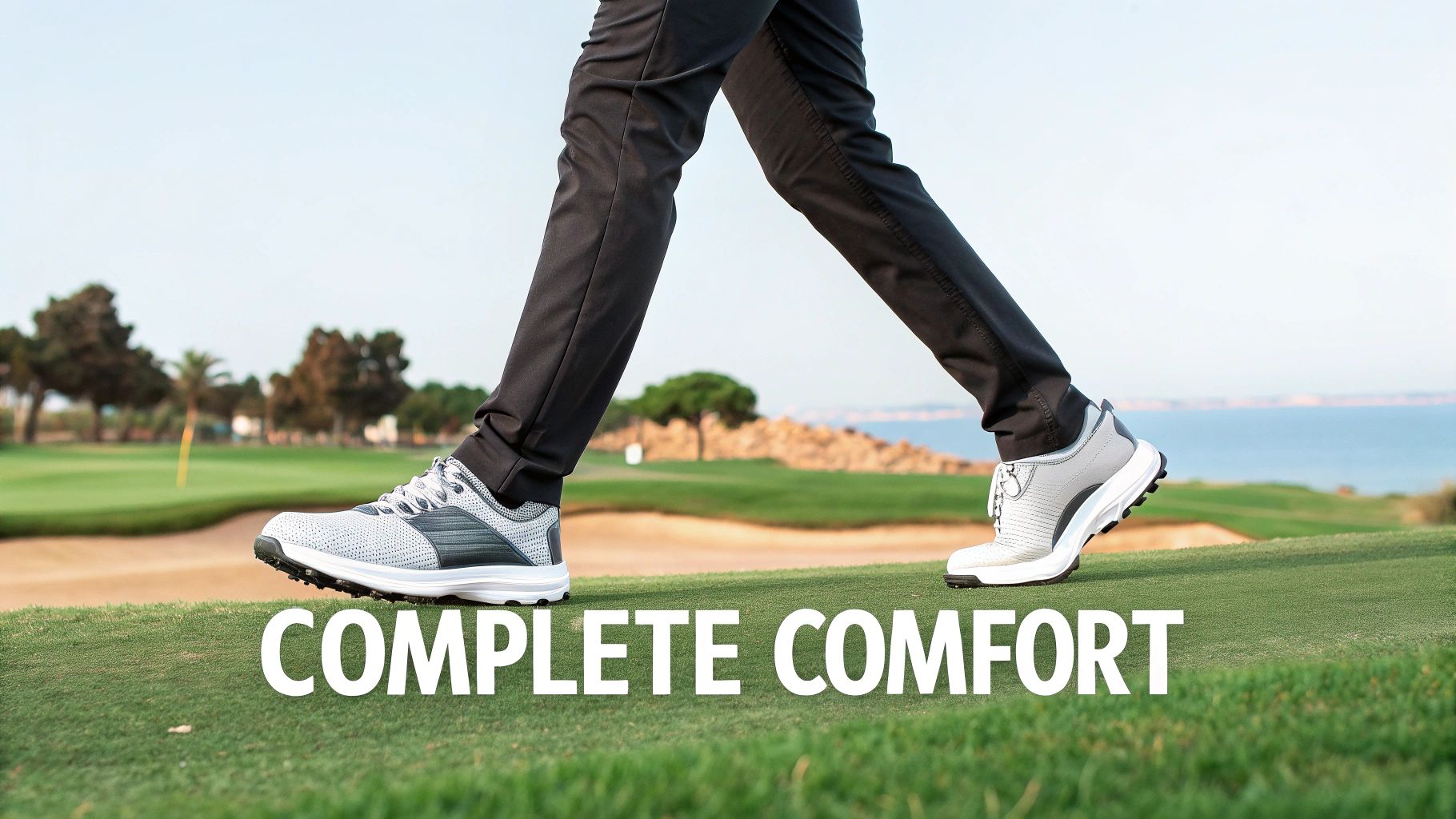
Before you obsess over that new driver, let’s talk about the foundation of your entire game: your feet. A typical 18-hole round will have you walking five to six miles. The wrong shoes can turn a beautiful day on the links into a painful slog. Blisters, achy feet, and an unstable base are certified round-killers.
This guide is for the golfer who walks the course and knows that comfort is completely non-negotiable. It’s no accident the golf shoe market is booming.
The global golf shoe market, valued at US$8.58 billion in 2022, is projected to grow to nearly US$13.33 billion by 2032. That explosion is driven by golfers like you who demand shoes that deliver on both performance and walking comfort.
The Modern Walking Golf Shoe Explained
Today’s best golf shoes for walking are a brilliant hybrid. They’ve got the cloud-like cushioning of a running shoe fused with the locked-in stability of a traditional golf shoe. They are engineered from the ground up to support every step and every swing, so you never have to choose between comfort and control.
To find the right pair, you have to look past the brand hype and get into what makes a shoe truly great for walking. These are the core elements that separate a forgettable shoe from one that genuinely improves your game.
- Responsive Cushioning: This is your shoe’s suspension system, absorbing the impact of thousands of steps and fighting off foot fatigue.
- Purpose-Built Traction: This gives you a stable platform for your swing without making you feel like you’re clomping around on old-school cleats.
- Essential Support: A great shoe locks your foot in place, preventing the internal sliding that robs your swing of power and consistency.
- Weatherproofing: This is vital for keeping your feet dry through morning dew or an unexpected shower, which is your best defense against blisters.
Understanding these features is a huge first step in mastering the basics of golf 101 for beginners, because having the right equipment is just as crucial as having a solid swing. Consider this your roadmap to making a smart, informed choice.
The Anatomy of the Perfect Walking Golf Shoe
So, what really sets a great walking golf shoe apart from an average one? It all comes down to engineering. A top-tier shoe isn’t just about one standout feature; it’s a complete system where every part works in harmony to give you comfort and stability, hole after hole.
Once you understand how they’re built, you can see past the marketing jargon and focus on what actually matters on the course.
Think of the midsole as your shoe’s suspension. Just like the shocks on a car smooth out a bumpy road, the midsole cushions every step, protecting your joints from the constant impact of walking five-plus miles.
Materials like EVA foam or proprietary tech like Adidas’s Boost are designed to be both soft and springy. This responsive feel gives you a little energy back with each step, which makes a huge difference in fighting off fatigue on the back nine.
This diagram highlights the key features that form the foundation of an excellent golf shoe for walking.
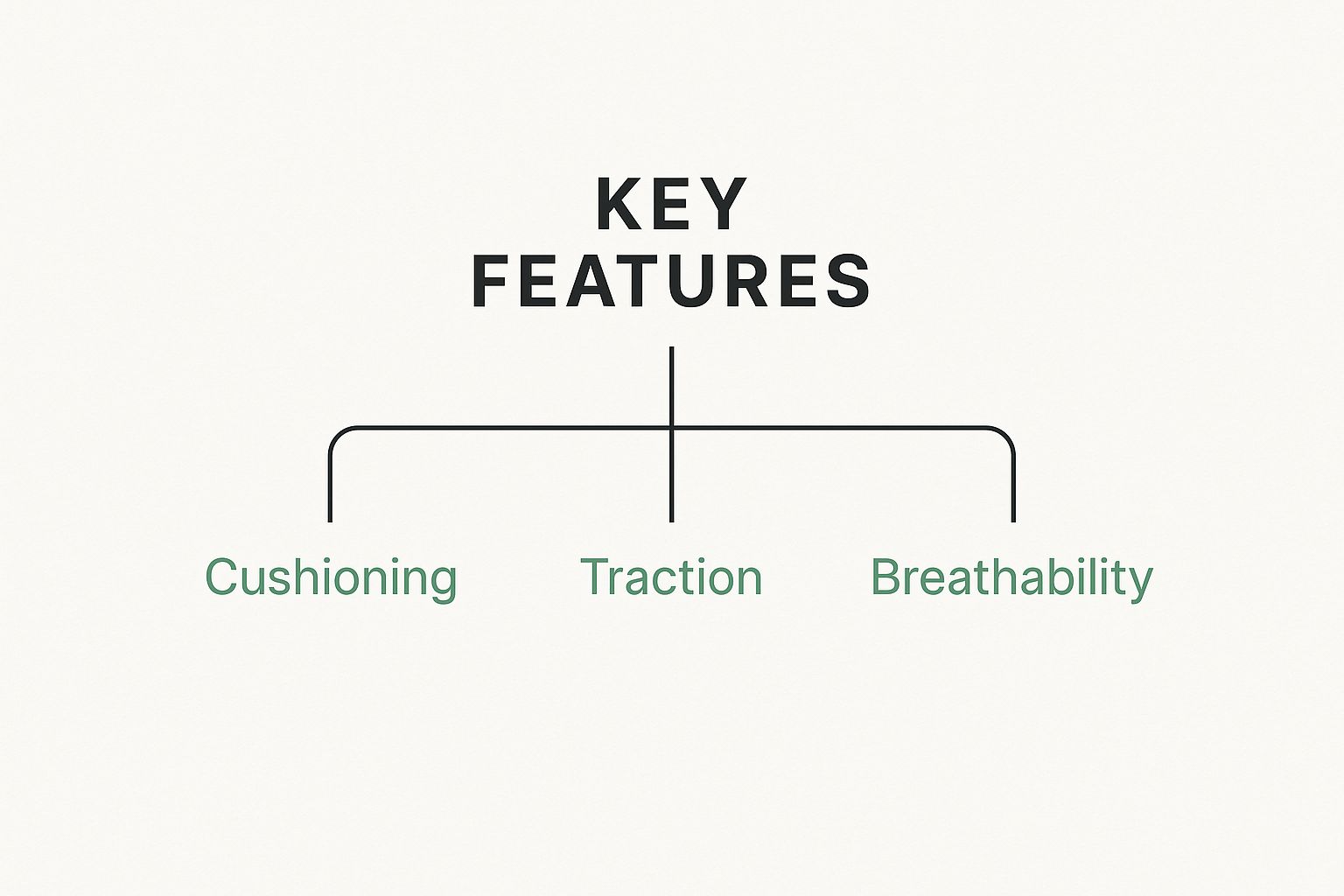
As you can see, the big three—cushioning, traction, and breathability—are all interconnected. They’re all essential if you want all-day performance out on the links.
The Foundation of Your Golf Swing
While the midsole handles comfort, the outsole is all about grip. This is where the rubber meets the turf, and its design is absolutely critical for keeping you stable during your swing.
A well-designed outsole gives you a tenacious grip without the harsh, rigid feel of old-fashioned spikes. Modern spikeless shoes use intricate lug patterns and durable rubber compounds, creating hundreds of traction points that hold firm on any terrain.
The final piece of the puzzle is the upper. This is what wraps around your foot, providing support, structure, and—crucially—protection from the elements. The materials used here directly impact the shoe’s weight, breathability, and flexibility.
A study of golfers found that the right footwear can seriously improve balance and stability—two things that are critical for generating power and accuracy. The upper’s job is to lock your foot in place, stopping those tiny internal movements that can rob your swing of its consistency and power.
How All the Pieces Work Together in Golf
No single component works in isolation. It’s the synergy between the upper, midsole, and outsole that creates the perfect walking golf shoe. A supportive upper is useless without a stable outsole, and a cushy midsole won’t matter if the upper is stiff and restrictive.
Here’s a quick look at the features you should be looking for and why they’re so important for a walking golfer.
Key Features of a Great Walking Golf Shoe
| Shoe Component | What to Look For | Why It Matters for Walking |
|---|---|---|
| Midsole | Responsive foam (EVA, Boost, etc.) with ample thickness | Absorbs shock from thousands of steps, reduces joint fatigue, and provides energy return to keep you fresh. |
| Outsole | Spikeless design with multi-directional lugs and durable rubber | Delivers stable, reliable grip on varied turf conditions without the pressure points of traditional spikes. |
| Upper | Lightweight, breathable, and flexible materials (mesh, knit, performance leather) | Secures your foot to prevent slipping, allows heat and moisture to escape, and moves naturally with your foot. |
| Heel Counter | A firm, structured cup around the back of the heel | Prevents your heel from lifting or sliding, which is crucial for stability during the powerful rotation of the golf swing. |
| Insole / Sockliner | Contoured, moisture-wicking, and removable for orthotics | Provides initial step-in comfort, manages sweat, and allows for customization to fit your specific foot shape. |
Ultimately, it’s about finding a shoe where all these components are engineered to function as a cohesive team.
Here’s a simple breakdown of how they support your game:
- Midsole Cushioning: This layer is the engine of comfort. It needs to be thick enough to absorb shock but not so mushy that you lose your feel for the ground. A responsive foam gives you a little energy back with each step, which is a huge factor in preventing leg fatigue on the back nine.
- Outsole Traction: This gives you the stable base you need for a powerful, balanced swing. The best designs offer grip in every direction, performing just as well on slick morning fairways as they do on dry, firm ground.
- Supportive Upper: This part is all about securing your foot, stopping it from sliding sideways during the rotational forces of your swing. Keep an eye out for designs with a snug heel cup and a solid lacing system to guarantee that locked-in fit.
When all these elements come together correctly, the result is a shoe that feels like an extension of your foot. It moves with you, supports you, and keeps you comfortable—letting you focus on your next shot instead of your aching feet.
Spiked vs. Spikeless Golf Shoes: Choosing Your Sole
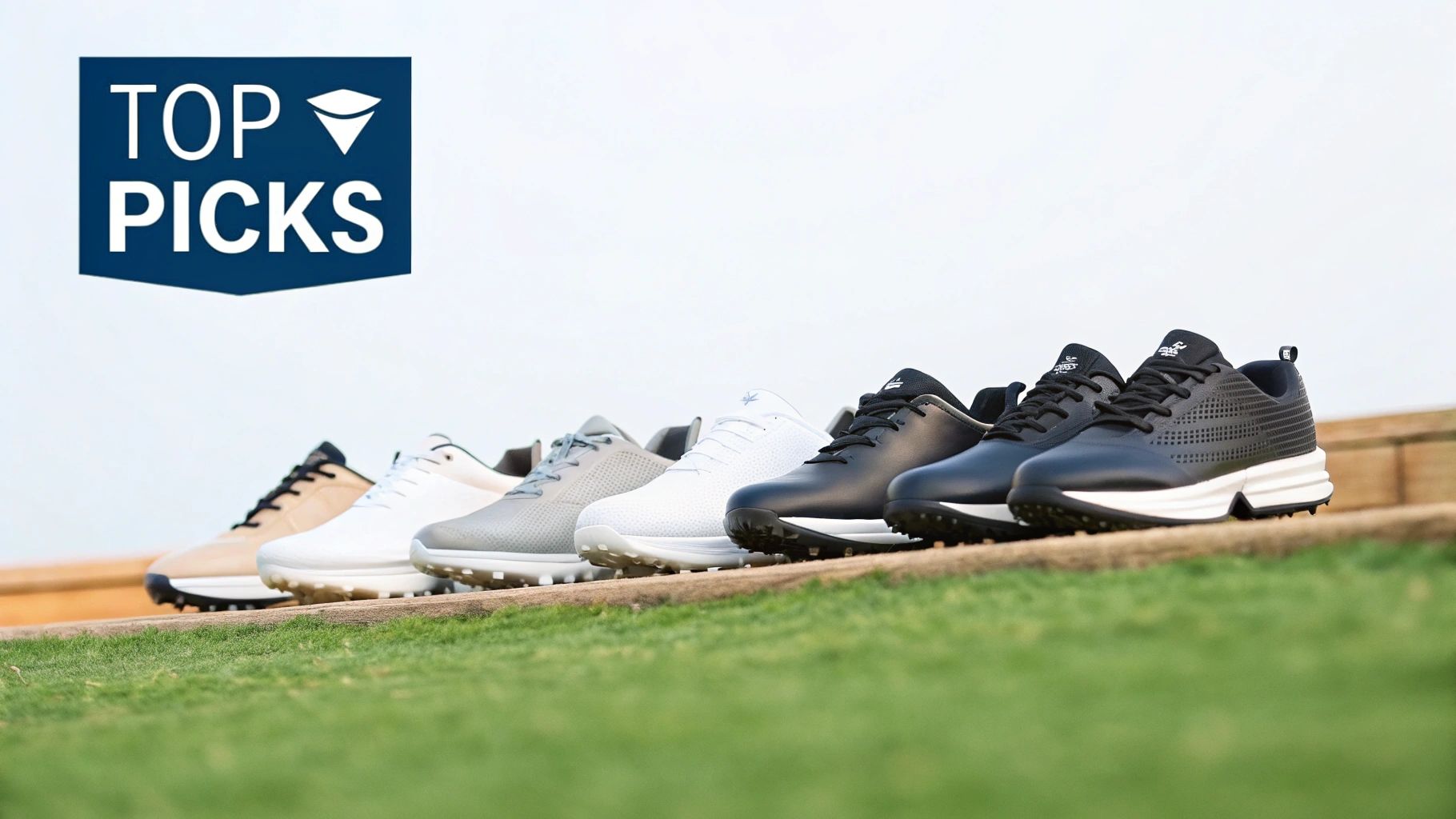
For golfers who walk, the spiked vs. spikeless debate is about way more than just grip. It’s a decision that impacts your comfort, your shoe’s versatility, and how connected you feel to the ground. It’s time to ditch the old myth that spikes are for pros and spikeless are for amateurs—modern tech has completely leveled the playing field.
The real decision boils down to your course conditions and personal preference. Think of spiked shoes as winter tires; they give you maximum, undeniable traction when things get wet, hilly, or slippery. Spikeless shoes are like high-performance all-season tires—they offer fantastic grip in most conditions but with a much smoother, more comfortable ride.
The Case for Spikeless Comfort Golf Shoes
Modern spikeless shoes are marvels of engineering. They deliver incredible, turf-grabbing traction using sophisticated lug patterns and specialized rubber compounds. These aren’t just sneakers with a few bumps on the bottom; they are purpose-built outsoles designed to anchor you firmly during your swing.
For walkers, though, the biggest selling point is pure, unadulterated comfort. Because the pressure is spread across dozens of small nubs instead of a few cleats, they feel much more like a regular athletic shoe on firm ground. This makes them perfect for wearing from your car, through the clubhouse, and straight to the first tee.
- Versatility: You can wear them on and off the course without a second thought.
- Comfort: The flexible sole and distributed pressure points mean less foot fatigue over 18 holes.
- Ground Feel: Being lower to the ground can actually improve your balance and your connection with the turf.
The Unmatched Grip of Spikes in Golf Shoes
While spikeless shoes have made incredible strides, there are still times when nothing beats the locked-in stability of traditional spikes. And today’s spiked models aren’t the rigid, heavy cleats your grandpa wore. They use lightweight, flexible designs with strategically placed cleats to deliver tour-level stability without sacrificing comfort.
In 2022, spiked golf shoes still held the largest market share at 33.1%, with spikeless shoes right behind at 26.49%. This shows that while many serious players still swear by the unmatched grip of spikes, the comfort-first spikeless models are catching up fast, especially among walkers. You can dig deeper into golf shoe market trends on RunRepeat.com.
Think about it this way: If you often play a hilly course that gets soaked after a rainstorm, the deep-penetrating grip of spikes is going to give you confidence you just can’t get otherwise. But for a firm, dry, and relatively flat track, the all-day comfort of a spikeless model is tough to argue with.
Ultimately, the best golf shoes for walking aren’t defined by one type of sole. The ideal choice is the one that best matches your typical course conditions and what your feet are telling you they need. In fact, many serious walkers keep a pair of each in their trunk, swapping them out based on the weather forecast.
How Golf Shoe Materials Impact Your Walk
The material your shoe’s upper is made of is your first line of defense against the elements and a huge factor in how your feet feel after five miles. Think of it like a car’s body; it protects everything inside, plays a big part in the overall weight, and defines the look. Choosing the right material is a balancing act between breathability, waterproofing, and durability.
For years, full-grain leather was the king of the course. It’s tough, offers incredible support, and eventually molds to your foot for a custom fit. But, like a classic car, it requires some break-in time and consistent care to stay in top shape.
The Rise of Modern Synthetics in Golf Shoes
Modern performance meshes and synthetic uppers are today’s high-tech sports cars. They’re lightweight, nimble, and ready to perform right out of the box. These materials are engineered for maximum breathability, letting heat and sweat escape, which is a game-changer on a hot afternoon.
You can wear them straight from the store with virtually no break-in period, and they’re usually much lighter than leather, meaning less fatigue over 18 holes. The trade-off? They might not offer the same longevity or custom-molded feel you get from premium leather after a few dozen rounds.
The best walking golf shoes often use a smart blend of materials. You might find a shoe with lightweight synthetic mesh in the forefoot for flexibility, combined with more structured synthetic leather around the heel for extra stability during your swing.
Staying Dry on the Golf Course with Waterproof Technology
Nothing ruins a round faster than soggy feet. This is where modern waterproofing comes in, and it’s far more sophisticated than a simple rubber coating.
The most famous name in the game is Gore-Tex, a membrane with microscopic pores that acts as a one-way gate. Imagine a screen door with holes so tiny they let air out but are too small for water droplets to sneak in. It blocks rain and morning dew while allowing sweat to escape, keeping your feet dry from both the inside and out.
This focus on advanced materials is a huge driver in the golf shoe world. New tech like waterproof Gore-Tex, breathable mesh, and super-light designs have made walking the course more comfortable than ever. At the same time, growing environmental awareness is pushing manufacturers to explore sustainable materials. You can dig deeper into these industry shifts in the Grand View Research golf shoe market report.
Ultimately, picking the right material comes down to a few personal questions:
- Climate: Do you play in hot, dry conditions or somewhere rain can appear at any moment?
- Frequency: How often do you play? If you’re on the course constantly, the durability of leather might be worth it.
- Maintenance: Are you willing to care for leather, or do you prefer a wipe-and-go synthetic?
Answering these will point you toward the material that will keep your feet happy from the first tee to the 18th green.
Golf Shoes: Finding the Perfect Fit to Avoid Pain

Let’s be clear: the most expensive, technologically advanced golf shoe is worthless if it doesn’t fit properly. A bad fit is a direct path to blisters, sore feet, and an unstable swing, ruining your round before you even make the turn. Getting the right fit is about more than just knowing your size number.
Your feet naturally swell during the day, especially after you’ve been walking on them. That’s why you should always try on new golf shoes in the afternoon. You’ll get a more accurate sense of fit when your feet are at their largest, helping you avoid that dreaded mid-round squeeze.
And please, bring the socks you actually golf in! A thick, cushioned golf sock will make a shoe fit completely differently than the thin dress socks you might have worn to the store.
The Anatomy of a Perfect Fit in Golf Shoes
When you slide your foot into a new shoe, you’re looking for that sweet spot between snug and spacious. You want a secure, locked-in feel without any pinching, cramping, or rubbing.
Run through this mental checklist:
- Toe Box Room: You need about a half-inch of space—roughly your thumb’s width—between your longest toe and the end of the shoe. This allows your toes to spread naturally as you walk and pivot.
- Heel Security: While your toes need space, your heel needs to be locked down. Walk around the store. If you feel your heel lifting or slipping, that’s a major red flag for blisters and instability.
- Midfoot Snugness: The shoe should gently hug the middle of your foot, preventing it from sliding side-to-side during the powerful rotation of your swing.
A common mistake is buying shoes that are too tight, assuming they’ll “break in.” While high-quality leather will mold to your foot over time, a shoe that is fundamentally too small will only ever cause you pain.
Lacing Systems for a Custom Feel in Golf Shoes
Think of the lacing system as the final tool for fine-tuning your fit. Traditional laces are a classic for a reason—they’re reliable and let you customize the tightness across different parts of your foot.
Many modern shoes, however, now feature innovative options like the BOA Fit System, which uses a micro-adjustable dial and super-strong, thin laces. For walking golfers, this can be a game-changer. You can dial in the exact pressure you want for a perfectly even, secure fit that won’t loosen during your round. It’s all about creating that custom feel for all 18 holes.
Making Your Golf Shoes Last Longer
A great pair of walking golf shoes is an investment in your comfort, your stability, and your game. And like any good investment, it pays to protect it. A simple care routine is the best way to ensure your shoes perform well season after season.
The most important step happens the moment you walk off the 18th green. Don’t just toss your shoes in the trunk. Take a minute to wipe them down with a towel to get the loose dirt, sand, and grass off before it has a chance to set.
Once they’re clean, let them air dry naturally. This is non-negotiable. Never use a hairdryer or stick them on a radiator. Intense, direct heat will crack the materials and weaken the adhesives holding your shoes together. A great tip is to stuff them with newspaper to absorb excess moisture and help them keep their shape.
Simple Care for Different Materials in Golf Shoes
Not all golf shoes are created equal, so they don’t all require the same care. A little specific attention goes a long way.
- Leather Shoes: For caked-on mud, use a soft brush. Every few rounds, treat them with a quality leather conditioner to keep the material supple and prevent it from drying out and cracking.
- Synthetic & Mesh Shoes: This is the easy one. A little gentle soap and water is all you need. Use a soft cloth or brush to gently scrub away any stains, then wipe them clean with a damp cloth.
Proper maintenance isn’t just about looking sharp on the first tee. It’s about preserving the integrity of the shoe’s materials, ensuring they keep providing the support and waterproofing you paid for in the first place. That little bit of effort saves you a lot of money in the long run.
If you wear spiked shoes, check the cleats every so often. When they get worn down, your traction disappears, and that’s when slips happen. Learning how to pop in a new set of spikes is a simple, cheap fix that restores your shoe’s grip to like-new condition. For more great advice like this, check out our other guides on golf gear and tips.
Your Questions on Walking Golf Shoes Answered
Even with all this info, you might still have a few questions. That’s perfectly normal. Let’s tackle some of the most common ones that golfers have when they’re trying to find the perfect pair of walking shoes. This should clear up any lingering doubts and help you make a final decision with complete confidence.
Can I Wear Running Shoes to Golf?
It’s tempting, right? Your running shoes are probably incredibly comfortable. But the short answer is no, you really shouldn’t.
Here’s why: running shoes are designed for one thing—forward motion. A golf swing is the exact opposite. It’s a powerful, rotational movement that puts immense lateral stress on the sides of your feet. Running shoes simply lack the side-to-side stability to support that twisting motion, which can lead to inconsistent shots or even an injury.
And then there’s the sole. The flat, smooth bottom of a running shoe offers virtually zero grip on grass, especially if it’s the slightest bit damp. You need a dedicated golf shoe that’s built for both walking comfort and the turf-gripping performance your swing demands.
How Often Should I Replace My Golf Shoes?
For an avid golfer who walks the course regularly—say, once a week or more—a good rule of thumb is to start looking for a new pair every one to two seasons.
But honestly, the calendar isn’t the best measure. Your shoes will tell you when it’s time. Look for these tell-tale signs:
- Worn-Down Traction: On spikeless shoes, are the lugs and nubs looking smooth and rounded? They’ve lost their bite.
- Flat Midsole: Does the cushioning feel dead or compressed? If the shoe has lost its spring, it’s no longer absorbing shock effectively.
- Decreased Support: If the upper material feels stretched out and you notice your foot sliding around inside during your swing, the shoe has lost its crucial stability.
If you wear spiked shoes, you can often extend their life by simply swapping out the spikes when they get worn down.
Remember, playing in worn-out shoes doesn’t just make your feet hurt; it actively harms your game by compromising the stable foundation your swing is built on.
Are Waterproof Golf Shoes Worth It?
One hundred percent, yes. For nearly every golfer, waterproof shoes should be considered a non-negotiable feature.
Even on a perfect, sunny day, the course is rarely completely dry. You are almost guaranteed to encounter morning dew, damp spots from sprinklers, or low-lying areas that hold moisture.
Wet feet are more than just uncomfortable—they’re the number one cause of painful blisters that can completely derail your round. Most quality golf shoes come with at least a one-year waterproof warranty, and it’s a feature that provides priceless peace of mind. Knowing your feet will stay dry and comfortable no matter what the course throws at you is a huge advantage.
At Golf Inquirer, we believe the right gear empowers you to play your best and, more importantly, enjoy the game more. Explore our comprehensive guides and reviews to find everything you need to elevate your experience on the course. Visit us at https://golfinquirer.com to dive deeper into the world of golf.

